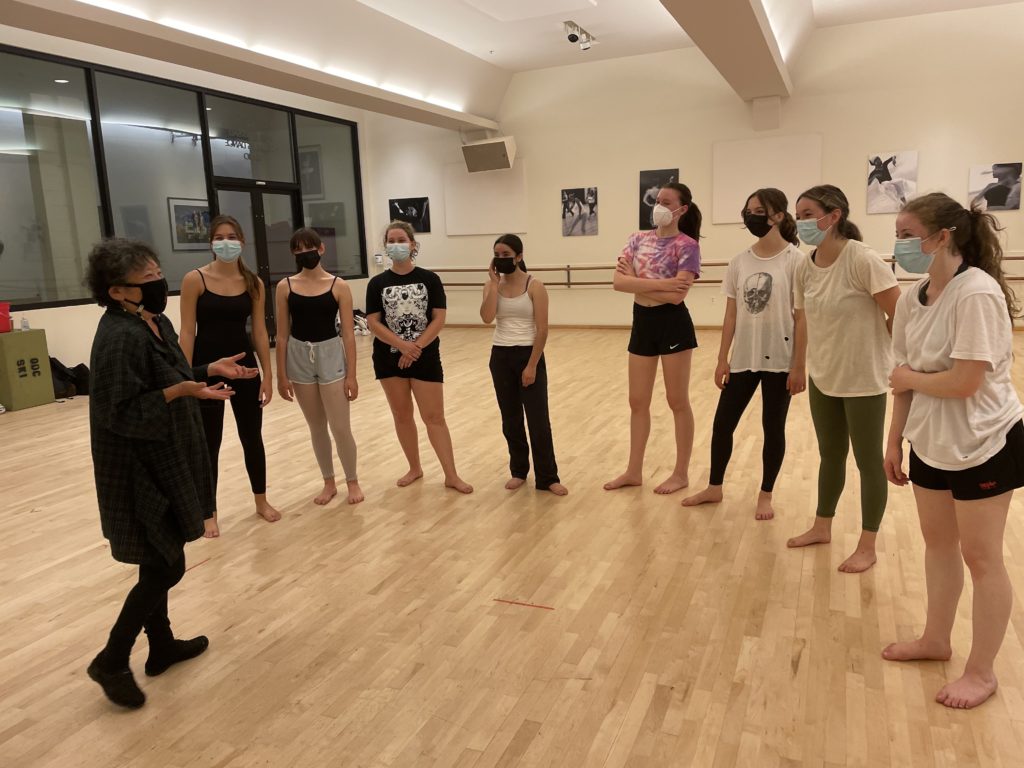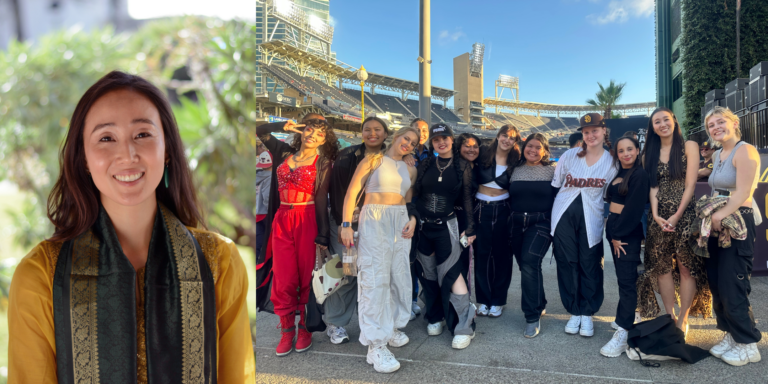
On a cool September evening in Alameda, California, I and over a hundred Bay Area residents gathered in the parking lot of the Alameda Free Library. The innocuous space, seemingly universal in its purpose and design, was once part of a thriving tonarigumi—an historic Japantown neighborhood.
As part of a community art walk to honor the history of this Japantown, ODC/Dance performed an excerpt of May’s Letters. Choreographed by Kimi Okada with Brenda Way, the dance is inspired by the letters Okada’s mother wrote during internment at Tule Lake in 1942. As the dancers took their bow I heard several murmurs: “Did you know about Alameda’s Japantown?” and “I had no idea.” It made me recognize that dance education is more than technique and composition. It often extends outside the walls and sprung floors of studios. And in this case, a parking lot became a site of history and creativity for a dance that was able to not only educate, but also bring a story to life.
I spoke with Kimi Okada, the ODC’s school director and associate choreographer, and two other Asian dance educators and artists—Peiling Kao, the associate professor of dance at the University of Hawai’i at Mānoa, and Nadhi Thekkek, the artistic director of Nava Dance Theatre—about the many ways in which they are expanding the field of dance education through their own personal histories. Given their cultural heritage from Japan, Taiwan and India, respectively, and dance practices that range from circus to postmodern to bharatanatyam, their experiences affirm the rich and vast diversity within the Asian American experience.
Here Okada, Kao and Thekkek share how they strive to preserve their identity and cultural heritage through their teaching practices so that their students can achieve a broader, more futuristic vision of dance.
KIMI OKADA, ODC School Director and Associate Choreographer

One of the things that has given me a different overview is that I came to administration as an artist, and still maintain being an artist and a choreographer. The art part is so connected to the mission of ODC. How do you keep that alive in a way that maintains the core values of what we started with? And how do you realize that in a curriculum that feels true to our values? It’s really about seeing what else is going on in the world artistically, politically, socially. I always say that any student that comes in the doors should have a whole world opened up to them—they’re not just coming to learn a few moves in a studio. It’s about really learning life skills that you’re going to take with you wherever you go, whether you’re going to become a dancer or not. It’s hugely important to me. The definition of what dance is, and what art is, is really broad. Dance education is not defining one type of dance as the “art.” That kind of appetite for expansive thinking and viewing has always been really important to offer students.
I think we distinguish ourselves by having the creative component be part of the curriculum. We’ve always had challenges creating an appetite for choreography classes. “Choreography” and “composition” sounded too academic or dry for our Youth & Teen Program. As a solution, we started building composition and creative exploration into our technique classes—either 15 minutes at the end of class or have a week or two dedicated to it. Then we started offering performance opportunities and performance classes so that there was a chance for kids to be in the creative process of making something and having it culminate in sharing work. The value is about learning the craft of expression.
I really believe creativity needs to be taught with tools to know how to access it, how to frame it, and how to think about it. Learn how to talk about it, how to have arguments about it. For me it’s been very important for that to be present in our curriculum, not just if you’re going to be a choreographer, but that anybody who loves art is able to talk about it. We’ve been hearing our whole lives, “Oh, I don’t know anything about modern dance. It scares me, I don’t know what to say, I can’t go there.” It’s OK to say “I felt this way.” At a really young age it’s important to know that art isn’t in an ivory tower, or isolated, or unapproachable, or private. It can be all those things. But it’s about openness.
ODC was founded on the transformative power of art. That’s what we believed in. We believed it as a company and the work we made, and as we developed the theater and the school. It’s not how enriching it can be, but how essential it is. Art is not an enrichment, it’s a necessity. That’s what we believe in. I think that the weight of importance is only going to be learned by kids having an amazing experience when they’re young.
PEILING KAO, Associate Professor of Dance, University of Hawai’i at Mānoa

The University of Hawai’i is really culturally diverse in terms of dance, so I’m in a very special geographic location. Students have to take some classes in Asian Pacific dance styles in order to fulfill the requirements of a dance major or minor. We have Tahitian dance, Japanese dance, Okinawan dance, Philippine dance, Chinese dance and, of course, hula. This was eye-opening for me when I took on this role at the university in 2016 because it’s more diverse here as compared to Taiwan, where I mainly studied local dance styles or ballet and modern.
Since last year, we’ve been discussing ways to make Asian Pacific dance styles equal to modern and ballet. But some issues were raised by our students. They wanted to major in dance, but they didn’t want to take ballet and modern. They questioned us: “Why can’t I be a dance major just by taking hula or Chinese dance or Japanese dance?” And it made us think, “Why not?” It’s pushing the boundary to be open to other ways of thinking about what dance should be in higher education. And so we’re in the process of making Asian Pacific dance classes equal in credit value to modern and ballet. We’re also questioning what dance history should be taught here—why should it always be Euro-American dance history? Why don’t we also study hula and Hawaiian dance history?
I’m the first Asian faculty member hired in the university’s dance program after 40 years. But being Asian with an Asian accent, I don’t feel like a minority here. I feel like my presence is important for the Asian American students. They see somebody who looks like them teaching ballet, modern or Taiwanese dance.
Lately, I’ve been thinking about the method, the style and the choreographic theory of Asian dance styles and the best way to deliver all this information to my students. It’s challenging, and it feels like a huge learning curve for me. Somehow, I need to peel away the things that I’m a professional at—like postmodern—which I know inside out. But I don’t want to abandon it, because then I’ll end up being who I’m not. I still need to value my strengths while also considering my weaknesses. And it’s so strange to know that my weaknesses as a teacher is that I don’t know enough about Asian dance styles.
Teaching at the University of Hawai’i has given me an opportunity to look back at my roots and gain more confidence and knowledge from my past. How do I teach Merce Cunningham’s chance procedure and connect it to a larger, Zen idea which is actually from Asia? I’m still trying to incorporate more philosophies in my class. So it’s not just “Here’s a pioneer—study this person.” How can I connect it to my personal experience and create variation to bring in new ways of thinking?
NADHI THEKKEK, Artistic Director, Nava Dance Theatre

I think for us in the South Asian community, we have a lot of internalized oppressive structures in the way we think about anything, art especially. Just getting people to pay to see art in our community, or pay to buy art—visual or performance—feels like a huge task. And that varies across South Asia. I don’t know how to unpack that. I’m sure there are academics that do. I remember doing a crowdfunding campaign and was told not to say I’m paying the artists: “It looks like you’re trying to make money.” Why else am I doing the campaign? I’m trying to compensate. We are doing work that we should be paid to do. You’re the community we are doing it for, therefore you should pay. I had to say, “No, we are saying we pay the artists.” I know so many fantastic artists who are not getting paid at all. This is true across all dance.
There’s a lot of biases associated with gender. Many of the dancers are female and the musicians are often male. Artists don’t have a problem raising money to pay the musicians, but the dancers have to just be grateful for the opportunity. I talk to my dancers when they go to work on other projects about it being OK to ask what the budget is; even if there’s no budget at least you’ve started that conversation. For me it’s about changing the culture, educating our dancers and audiences about that culture. This is work, this is labor, and it needs to be compensated. Some people tell me not to be so money-minded. If I were interested in money, I wouldn’t be in dance.
Externally, we’ve started this program called Unrehearsed Activism. It’s largely an education program. There’s a ton of racism, a ton of casteism in the South Asian community. A lot of it is under the rug and not really talked about, unless you’re from a marginalized community. I think those conversations need to happen more, especially in the Bay Area, where there are literally court cases about casteist policies in companies. In Silicon Valley you’ll have people from different communities working together, and if there’s casteism among South Asians, the general management may not really see it or understand it, but how do we bring those inequities to their attention so they can keep track? That’s a larger goal, and it happens in dance also for sure. People from the dominant castes or who have more money get more opportunities than people from marginalized communities or oppressed castes. We have a steering committee, and we’re creating panels and engagement events that are art- centered to bring in the parents and teachers and students who funnel money into this system through arts learning. We want to educate them about what exists and have the context. A part of the program is artist commissions. The goal is to disrupt the hierarchy in Indian dance, which is classical versus folk versus Bollywood. This hierarchy is inculcated. It comes from a political place. It doesn’t feel like it’s about the art. The word “classical” is not an Indian word. It’s a Western word that was used to make a statement during India’s independence about the art form. Why this hierarchy, when I know brilliant artists with beautiful work in all genres? I want to see artists from all these places. Art is soft politics. Art is a reflection of the politics that are happening in our communities. Art reflects the hierarchies outside of dance.




